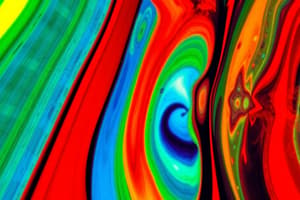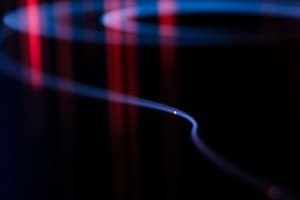Podcast
Questions and Answers
What is the difference between sensation and perception?
What is the difference between sensation and perception?
Sensation is the physical processing of environmental stimuli by the sense organs, while perception is the psychological process of interpretation of sensory information.
What is psychophysics?
What is psychophysics?
Methods that measure the relationship between the strength of a stimulus and the observer's sensitivity to that stimulus.
What is an absolute threshold?
What is an absolute threshold?
The minimum stimulation needed to detect a particular stimulus 50% of the time.
What is Just Noticeable Difference (or JND)?
What is Just Noticeable Difference (or JND)?
What is signal detection theory?
What is signal detection theory?
What is the difference between top-down and bottom-up processing?
What is the difference between top-down and bottom-up processing?
What is sensory adaptation?
What is sensory adaptation?
What is selective attention?
What is selective attention?
How is light projected on the eye's retina?
How is light projected on the eye's retina?
What are the two types of photoreceptors in the eye?
What are the two types of photoreceptors in the eye?
How does the retina work?
How does the retina work?
What are the two theories about color vision?
What are the two theories about color vision?
What is the visual projection pathway inside the brain?
What is the visual projection pathway inside the brain?
What are the two processes streams of visual information after the primary visual cortex?
What are the two processes streams of visual information after the primary visual cortex?
What are monocular depth cues?
What are monocular depth cues?
What are binocular depth cues?
What are binocular depth cues?
What is multimodal perception?
What is multimodal perception?
What is the McGurk effect?
What is the McGurk effect?
What is the difference between point of objective equality and point of subjective equality?
What is the difference between point of objective equality and point of subjective equality?
Flashcards are hidden until you start studying
Study Notes
Sensation and Perception
- Sensation involves the physical processing of environmental stimuli through the sense organs, while perception involves interpreting these sensory inputs psychologically.
Psychophysics
- Psychophysics measures the relationship between stimulus strength and observer sensitivity, determining thresholds of perception.
Absolute Threshold
- The absolute threshold is the minimal stimulation required to detect a stimulus 50% of the time.
Just Noticeable Difference (JND)
- JND refers to the smallest difference between two stimuli that can be detected 50% of the time, influenced by the intensity of the original stimulus.
Signal Detection Theory
- This theory proposes that response to a stimulus is influenced by both sensory sensitivity and decision criteria, which include experience, expectations, motivation, fatigue, and potential consequences.
Top-Down vs. Bottom-Up Processing
- Top-down processing uses expectations and prior knowledge to influence perception, while bottom-up processing constructs perception from individual sensory bits.
Sensory Adaptation
- Sensory adaptation leads to diminished sensitivity due to constant exposure to the same stimuli.
Selective Attention
- Selective attention focuses on specific tasks, potentially causing inattentional blindness (missing objects not in focus) and change blindness (failure to notice changes in visual scenes).
Light Projection on the Retina
- Light is bent by the cornea and lens, projecting an upside-down and reverse image onto the retina.
Photoreceptors in the Eye
- Two main types of photoreceptors:
- Cones (6 million, located centrally) detect color and fine detail.
- Rods (120 million, located peripherally) are sensitive in low light but do not detect color.
Retina Function
- Photoreceptors transform light into neural signals (transduction), and ganglion cells process this information before sending it to the brain via the optic nerve.
Color Vision Theories
- Trichromatic color theory suggests three types of cones sensitive to different light wavelengths but does not explain negative afterimages.
- Opponent process theory proposes color perception in opposing pairs and explains rebound effects when particular colors are no longer perceived.
Visual Projection Pathway
- Visual signals travel through the optic nerve to the brain, passing through the thalamus and arriving at the Primary Visual Cortex.
Streams of Visual Information
- After the Primary Visual Cortex, visual information is processed through:
- Dorsal stream ("Where pathway") for spatial awareness.
- Ventral stream ("What pathway") focused on object and face recognition, with conditions like visual agnosia and prosopagnosia affecting recognition.
Monocular Depth Cues
- Monocular depth cues provide depth information using one eye, including aspects such as relative height, size, linear perspective, interposition, light, and shadow.
Binocular Depth Cues
- Binocular depth cues involve retinal disparity, allowing distance estimation from differing views of the two eyes.
Multimodal Perception
- Multimodal perception relates to how simultaneous activation of multiple senses influences the perception of events and objects.
McGurk Effect
- The McGurk effect illustrates the interaction of visual and auditory stimuli in speech perception, creating an illusory perception of a different sound when mismatched visual and auditory inputs are combined.
Points of Objective Equality vs. Subjective Equality
- Point of Objective Equality (POE) is the moment when a comparison stimulus physically matches a standard stimulus, whereas Point of Subjective Equality (PSE) occurs when a comparison stimulus is perceived as equal to a standard stimulus.
Studying That Suits You
Use AI to generate personalized quizzes and flashcards to suit your learning preferences.




